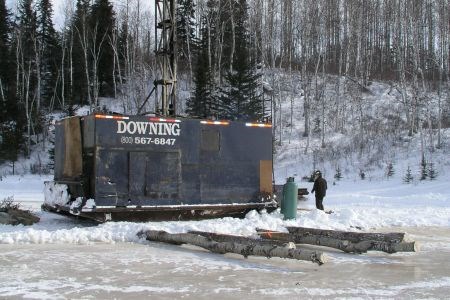The economics look good so far for a potential open pit base metals mine near Thunder Bay.
Australian miner Magma Metals was finalizing its plans for an ambitious summer exploration program to expand the mineral resource on its Thunder Bay North project.
On the heels of a favourable preliminary economic assessment, the Perth-based company has about 40,000 metres of drilling pencilled in this year to enlarge its platinum-palladium-copper-nickel discovery, as well as go searching for new deposits.
“We’ve been very focussed on that one area and we’re going to try and build that resource to get it bigger and more profitable,” said exploration manager Allan MacTavish.
Located 45 kilometres northeast of Thunder Bay, the junior miner has been quietly drilling multiple zones since its first discovery hole on the shores of Current Lake in 2006.
Thunder Bay North is the company’s only North American project, but it’s quickly become its flagship property.
A PEA — also known as a scoping study — is the first of three steps, prior to the pre-feasibility and feasibility stages, before a decision is made to mine.
Magma’s consultants have outlined a $207-million open pit mine and mill operation where 10 million tonnes of material, at an average grade of 1.9 grams per tonne platinum-equivalent, would be extracted over a seven-year life.
The company believes the project has considerable upside.
“There’s definitely potential for more resources to the southeast,” said MacTavish.
A potential mine would begin its operational life starting with an open pit at Current Lake, before dipping underground toward the south in the Beaver Lake area.
After spending last year infill drilling on its deposit, Magma is following a trail of mineralization to the southeast where it remains open at a depth beyond 350 to 375 metres.
“Our push for 2011 is stepping out from the known resource with the idea of adding to the resource plus checking other targets in the project that have not been tested,” said MacTavish.
Magma has some secondary grassroots projects to the north and west of its main camp, having recently wrapped up an 11,000-metre winter drill program in April. It needed lake ice and frozen swamps to test targets for more aggressive exploration in 2012.
Since a big chunk of the resource lies under Current Lake, if a mining decision is made, all or part of the lake would be dammed up and drained, but MacTavish said it's considering “multiple scenarios.”
There are cottage owners to talk to and an agreement needs to be struck with area First Nations on a memorandum of understanding.
MacTavish said Magma staff will spend this year fine-tuning the project’s capital and operating costs, particularly on the mineral processing side.
Logistics certainly works in the project’s favour as the exploration camp is 25 kilometres down an access road from Highway 527.
A pre-feasibility decision likely won’t take place this year, said MacTavish.
While an operating mine may be a ways off, the economic spinoffs from exploration are felt in Thunder Bay.
MacTavish said almost all of the 14 to 16 permanent and seasonal staff live in the city. Its contract drillers and assay lab have a presence in town and hire locals.
“A good chunk of what we spend each year on exploration is spent locally,” said MacTavish.
Magma had $9.3 million in cash in its treasury at the end of December.
The success of companies like Magma, North American Palladium, Osisko Mining’s Hammond Reef gold project in Atikokan, and the acquistion of Marathon PGM by Stillwater Mining, has breathed new life into the Thunder Bay area.
John Scott, the Ontario Geological Survey’s resident geologist for the Thunder Bay South district, said interest in the area remains high, partly sparked by activity in the Ring of Fire far to the north.
After Magma’s discovery, global mining giant Rio Tinto began quietly poking around the Thunder Bay North project searching for nickel and copper.
Scott said the geology is the same as that in upper Michigan where Rio Tinto is constructing its Eagle nickel and copper mine.
“It’s the same type of rock as we have here, rocks associated with the Midcontinent Rift.”
Northern American Palladium continues to explore at its Lac des Iles Mine and is collaborating with Brazilian miner Vale on an advanced exploration program at its Shebandowan West project, 90 kilometres west of the city. The company assembled a 2,800-hectare land package on the site of the former Shebandowan mine looking for nickel, copper and platinum group metals.




